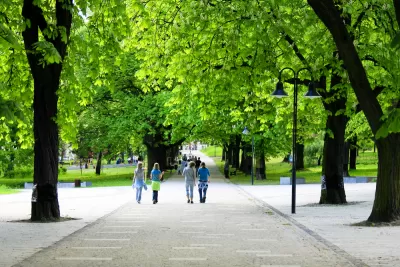The healthiest neighborhoods are both walkable and green, according to a growing body of evidence.

Kaid Benfield puts out a call to action better connect place to health. According to Benfield, the formula for success in bringing better health outcomes to communities is simple: nature and walkability.
According to Benfield, "there is compelling new research, from a variety of medical and other scientific sources, about what makes a neighborhood healthy." While walkability has long been an urban design feature sought by urban designers and other advocates for smart growth, another piece is necessary to deliver the most health benefits. "To be truly healthy, especially in cities, we also need nature in our communities," explains Benfield.
The article sets context with past research public health outcomes connected to the environment, like obesity and asthma. There are a few potentially surprising environmental conditions with a direct connection to public health outcomes, like noise pollution. One of the new studies shared by Benfield offers a "meta-analysis of urban and rural differences in mental health, finding "the incidence of mood disorders (mostly depression) was 39 percent higher and the incidence of anxiety disorders was 21 percent higher in cities than in rural areas."
Belfield doesn't present this information to present urban living in a negative light. Rather, he writes, "city environments can also be very supportive of health if we get the neighborhoods right." The article goes on to share studies that delve into the characteristics of walkability and urban nature than can deliver the most benefit top public health outcomes. There's a ton of research and information here.
FULL STORY: The Science Is In: The healthiest neighborhoods are both walkable and green

Planetizen Federal Action Tracker
A weekly monitor of how Trump’s orders and actions are impacting planners and planning in America.

San Francisco's School District Spent $105M To Build Affordable Housing for Teachers — And That's Just the Beginning
SFUSD joins a growing list of school districts using their land holdings to address housing affordability challenges faced by their own employees.

The Tiny, Adorable $7,000 Car Turning Japan Onto EVs
The single seat Mibot charges from a regular plug as quickly as an iPad, and is about half the price of an average EV.

Trump Approves Futuristic Automated Texas-Mexico Cargo Corridor
The project could remove tens of thousands of commercial trucks from roadways.

Austin's First Single Stair Apartment Building is Officially Underway
Eliminating the requirement for two staircases in multi-story residential buildings lets developers use smaller lots and more flexible designs to create denser housing.

Atlanta Bus System Redesign Will Nearly Triple Access
MARTA's Next Gen Bus Network will retool over 100 bus routes, expand frequent service.
Urban Design for Planners 1: Software Tools
This six-course series explores essential urban design concepts using open source software and equips planners with the tools they need to participate fully in the urban design process.
Planning for Universal Design
Learn the tools for implementing Universal Design in planning regulations.
Smith Gee Studio
City of Charlotte
City of Camden Redevelopment Agency
City of Astoria
Transportation Research & Education Center (TREC) at Portland State University
US High Speed Rail Association
City of Camden Redevelopment Agency
Municipality of Princeton (NJ)





























